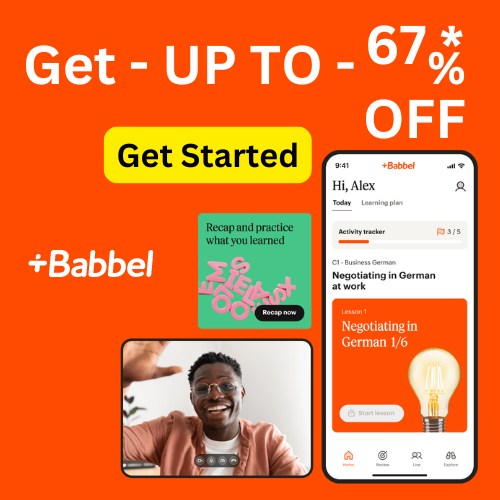
Hola Amigo! The Top 5 Platforms for Learning Spanish
- Learn the 3rd most common internet language
- Excel in Spanish phonetics and pronunciation
- Improve by interacting with native speakers
- Experience latin culture while learning
Lingoda
750k course per year for every learner
Babbel
Discounted award-winning language courses
Italki
Interactive visual learning methods for every need

- Start learning at $8.45/mo*
- 10-minute learning sessions
- Learn conversational Spanish in 20 days
- Research built learning curated by 200+ experts
See More Info
Why Do We Recommend it?
15+ years of language teaching
More than 47.4 million app downloads globally
SSL certified encryption available
All language access gifting options available

- Verified community tutors at just $5/hour
- 1:1 and group sessions available
- Join free community to learn and practice anywhere
- Interactive methods like podcasts, quiz for learning
See More Info
Why Do We Recommend it?
10 million+ happy learners over globally
149+ languages to learn from.
Engaging revision with different prompts and quiz.
Multiple resources and challenges for effective learning

- Start learning at just $10.50 /class
- 7-day free trial available
- Personalized feedback for faster learning
- Best for learning conversational Spanish
See More Info
Why Do We Recommend it?
Choose from different packages for different learning needs
Placement test available for beginners for
5 other languages available for learning
Learn about culture and explore tradition

- 30-day money back guarantee
- Start learning at just $15.99/mo*
- School and enterprise learning solutions
- Speech recognition to improve pronunciation
See More Info
Why Do We Recommend it?
20+ other languages available
Immersive learning for lasting results
Offers specialized training for learners
Dedicated blog and newsroom for updates

- Start learning at just $3 /per session*
- Best for 1:1 learning sessions
- Advanced filters to pick out best tutors
- Communicate with tutors before booking a class
See More Info
Why Do We Recommend it?
40,000+ tutors for 50 different languages
Demos available for corporate training
Intense verification process to ensure session credibility
Language training for employee relocation available
Comparison of Spanish Learning Platforms: Lingoda, Babbel, italki, Rosetta Stone, and Preply
When searching for the best resource to learn Spanish, it’s essential to consider factors such as price, accreditation, course duration, instructor quality, industry rating, and user experience. Here, we compare five prominent platforms: Lingoda, Babbel, italki, Rosetta Stone, and Preply.
1. Price/Precio
Lingoda: Offers monthly subscriptions starting at $8.00 per class. Packages can be more expensive depending on the number of classes.
Babbel: Plans start from $6.95 per month for a 3-month subscription. Prices decrease as the plan duration increases.
italki: Prices vary by tutor, ranging from $4 to $30 per hour.
Rosetta Stone: Plans start at $11.99 per month for unlimited access to courses.
Preply: Prices are highly variable, starting around $5 per hour, depending on the tutor.
Verdict— Babbel offers the lowest monthly cost with a flexible plan.
2. Accreditation/Acreditación
Lingoda: Not formally accredited but offers classes with a structured methodology and qualified teachers.
Babbel: No formal accreditation but is recognized for its science-based language learning method .
italki: Not accredited but offers a wide variety of certified and native tutors.
Rosetta Stone: One of the oldest platforms with some accreditation in the educational sector.
Preply: No official accreditation but features a broad range of tutors with various credentials.
Verdict— Rosetta Stone is the most recognized in the education industry.
3. Course Duration/ Duración de los Cursos
Lingoda: Lingoda Offers courses that fit different schedules and can be tailored to user needs.
Babbel: Provides structured courses ranging from beginner to advanced levels, with lesson durations of approximately 10-15 minutes.
italki: Class duration is flexible, depending on the tutor’s availability and the student’s preference.
Rosetta Stone: Provides unlimited access to content with varying lesson durations, allowing users to progress at their own pace.
Preply: Classes are customized and can adapt to the student’s availability and pace.
Verdict— Rosetta Stone offers unlimited content access, allowing users to learn at their own pace.
4. Instructors/Instructores
Lingoda: Certified instructors with experience in language teaching.
Babbel: Content created by linguists and language experts, but no direct interaction with instructors.
italki: Wide variety of native and certified tutors, allowing for complete personalization.
Rosetta Stone: No direct interaction with instructors; learning is autonomous.
Preply: Offers a wide range of tutors with different levels of experience and specializations.
Italki provides the most variety and flexibility with native and certified tutors.
5. Industry Rating/ Calificación en la Industria
Lingoda: Generally well-rated for its structured methodology and flexibility.
Babbel: High ratings for its science-based approach and quality content.
italki: Highly rated for personalization and tutor quality.
Rosetta Stone: Recognized in the industry with a solid reputation built over decades.
Preply: Good ratings for flexibility and tutor variety.
Rosetta Stone has a long-standing global reputation.
6. User Experience/ Experiencia del Usuario
Lingoda: Intuitive platform with efficient customer support and interactive classes.
Babbel: User-friendly interface with well-structured lessons.
Italki: Personalized experience with the option to choose tutors and schedules.
Rosetta Stone: Solid user interface but may be more challenging for beginners to navigate.
Preply: Flexible and easy-to-use platform with multiple tutor options.
Italki offers the most personalized and adaptable experience.
Final Verdict
Lingoda: Excellent for those seeking a more formal structure and are willing to pay a bit more for well-organized classes.
Babbel: Ideal for budget-conscious students who prefer learning at their own pace with short, accessible lessons.
Italki: Perfect for those who want total flexibility and a personalized learning experience with native tutors.
Rosetta Stone: Recommended for those who value tradition and extensive content with unlimited access.
Preply: A good option for those wanting flexibility in schedules and prices with a wide range of tutors.
How Did We Choose the Language Learning Platforms?
Pricing: We’ve evaluated prices in our review process, ensuring we recommend the most cost-effective platforms.
Course Duration: We have closely examined the average duration to help you understand their learning flexibility.
User Experience: We carefully evaluate the platform, its accessibility, support, and refund policies to ensure seamless user experience.
Industry Grade Rating: Brand reputation is analysed via credible third party platforms, online reviews, and our editors to make sure that the platform provides value for money.
Frequently Asked Questions
What are the best online resources for learning Spanish?
Some of the best online resources for learning Spanish include Duolingo, Babbel, Rosetta Stone, and SpanishDict. Each offers various tools like interactive lessons, vocabulary practice, and grammar explanations. Additionally, YouTube channels like Butterfly Spanish and SpanishPod101 provide excellent free content.
How long does it take to learn Spanish fluently?
The time it takes to learn Spanish fluently depends on various factors, including your native language, study habits, and immersion level. The Foreign Service Institute (FSI) estimates that achieving professional working proficiency in Spanish requires around 600-750 hours of study.
What are some effective methods for learning Spanish vocabulary?
Effective methods for learning Spanish vocabulary include using flashcards (physical or apps like Anki and Quizlet), engaging in spaced repetition, practicing with language exchange partners, and incorporating new words into daily conversations. Watching Spanish TV shows and movies with subtitles can also help.
Is it better to learn Spanish through immersion or structured courses?
Both immersion and structured courses have their advantages. Immersion helps you learn natural speech patterns and improve listening and speaking skills, while structured courses provide a systematic approach to grammar and vocabulary. Combining both methods often yields the best results.
How can I practice speaking Spanish if I don’t live in a Spanish-speaking country?
You can practice speaking Spanish by joining language exchange platforms like Tandem or HelloTalk, participating in online Spanish conversation groups, or taking online lessons with native speakers through platforms like iTalki and Preply. Practicing with friends who are also learning Spanish can be beneficial.
What is the best way to learn Spanish grammar?
The best way to learn Spanish grammar is through consistent practice and application. Use grammar textbooks, online courses, and apps like Duolingo or Babbel. Pay attention to sentence structures while reading Spanish texts and practice writing your own sentences. Regularly reviewing grammar rules and doing exercises helps reinforce your understanding.
Are there any good podcasts for learning Spanish?
Yes, there are several excellent podcasts for learning Spanish, including Coffee Break Spanish, Notes in Spanish, and SpanishPod101. These podcasts offer lessons at various levels and cover a wide range of topics to help improve listening skills and vocabulary.
How can I improve my Spanish listening skills?
To improve Spanish listening skills, regularly listen to Spanish audio materials like podcasts, music, and audiobooks. Watching Spanish TV shows, movies, and YouTube videos with and without subtitles is also effective. Practice active listening by focusing on understanding the context and main ideas.
What are some common challenges in learning Spanish, and how can I overcome them?
Common challenges in learning Spanish include mastering verb conjugations, understanding gendered nouns, and developing listening and speaking skills. To overcome these challenges, practice consistently, use language learning apps, seek feedback from native speakers, and immerse yourself in the language as much as possible.
Our Best Pick







